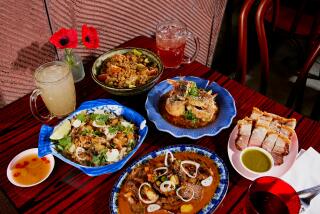Out of the Storefront, Into the Forefront : Cambodian cuisine may be as exotic and difficult as you can get, but New Paradise does it right
New Paradise is the newest, flashiest restaurant along Long Beach’s Anaheim Street, the vibrant center of Cambodian cultural life in Southern California. It’s a giant pink palace that seats 400, the sort of room you’d find in one of the newer restaurants in Hong Kong (or Monterey Park), but it’s dominated by an otherworldly back-lit mural of a tropical island.
Owner Chheang Saing’s first Long Beach restaurant, Peilin, was just a humble mom-and-pop setup. But this new place is a cosmopolitan paradise of palm trees, marble columns, brass-rimmed walls and crystal chandeliers.
Like Peilin, New Paradise serves both Chinese and Cambodian cuisines. That means two totally separate menus--written in two different non-English languages.
The Chinese menu is extensive: 152 dishes with names given in both Chinese and English, plus a dim sum menu at lunch. The Cambodian menu, written in the squiggly Khmer script, is much smaller, but it’s the heart and soul of this place. It lists 33 dishes, 15 of them given as N1 through N15, the rest designated by the letters A through R. This is a little confusing, but what makes it manageable is the restaurant’s team of charming, multilingual waitresses, who make good guides in helping you learn about Cambodian food.
It’s said that Cambodian is the most laborious to prepare of all Asian cuisines--there are a lot of minced meats and fish pastes. Some compare it to Thai food. But one thing is sure, it’s about as exotic as food gets.
The best Cambodian dish at New Paradise is called amok (letter J on the Khmer menu), which is catfish steamed in coconut milk until it’s almost a mousse, then wrapped in spinach and banana leaf. With your first bite, you think of France. With your second, the essences of lemon grass, ginger, coconut and banana dance across your palate.
Letter I, a sweet-and-sour lobster soup, is another must, though the Khmer name is so alien-sounding that I will not even attempt a transliteration. It’s a piquant red broth, heavy on the vinegar, and full of long beans, cilantro, red pepper and chunks of lobster meat served in a large silver tureen. It’s also unlike any soup I’ve ever tasted in a Thai restaurant. The same soup can be ordered with vegetables (letter E), beef (letter F), or fish (letter G). The lobster variant, I’m told, is the overwhelming favorite among the Cambodians themselves.
One dish bound to be popular with Westerners is the Cambodian sat go an , which isn’t on the menu but is definitely worth asking for. It’s a deliciously mild, slightly sweet satay of barbecued steak cut into chunks and skewered on long wooden picks. Unlike Thai satay , it’s eaten without peanut sauce.
Fried frog with curry, mong kayp cha krung (letter Q on the menu), might remind you of sauteed crab. The French may prize frog legs, but Cambodians saute the entire frog in a delicious melange of ginger, dry spices, onions and green pepper. The small pieces still contain bones, so eat them as you would eat pieces of crab . . . gingerly.
Dishes designated with the letter N are soups, available only in the morning and afternoon. Most of these soups are noodle-based with a variety of toppings. Cambodians usually eat them for breakfast. N3 is my favorite: a duck soup called kui diu sat dia that Groucho would have wiggled his eyebrows for. The duck has been stewed extra-soft with garlic cloves and cilantro leaves swimming around in the broth.
N4 is another interesting one, kui diu praw hat. The dense Cambodian beef balls, somehow, magically, float in their soup.
Excellent dim sum are served from the cart at lunch, prepared by a separate team of chefs that Saing brought over from Hong Kong. I tasted the black bean spare ribs, the mushroom siu mai (pork dumplings) and the steamed buns with barbecued pork. All were well above standard.
Then there is a healthy selection of traditional Chinese favorites: baked shrimp with spicy salt, crab with black bean sauce, pan-fried lobster with butter sauce, Peking duck. I actually think the Chinese menu is reason enough to visit this restaurant. But that’s the thing about Paradise, or at least New Paradise, you can have your Chinese, and Cambodian, too.
New Paradise
1350 E. Anaheim Street, Long Beach, (213) 218-0066.
Open seven days 7 a.m. to 10 p.m. MasterCard and Visa accepted. Parking available. Dinner for two, food only, $20-$40.
Recommended dishes: amok, catfish in coconut milk, $6; sweet-and-sour lobster soup, $8; fried frog with curry, $8; kui diu sat dia, duck soup, $2.95.
More to Read
Eat your way across L.A.
Get our weekly Tasting Notes newsletter for reviews, news and more.
You may occasionally receive promotional content from the Los Angeles Times.










